Determining the cost of switching from landlines to VoIP can feel like navigating a maze. You have to study different pricing plans and try to get the right combination of core and advanced features to fit your business needs.
But a business phone system isn’t just an expense — it’s a strategic investment in scaling your communication capabilities.
In this guide, we’ll break down the complexities of VoIP pricing for you, giving you a clearer picture of what a VoIP system might cost. We’ll also list the key cost factors and share practical tips to help you make a smart, budget-friendly decision for your business.
How VoIP Pricing Works
On average, a Voice over Internet Protocol (VoIP) phone system costs between $15 and $50 per phone line monthly. Additional features like call recording, toll-free numbers, and equipment rentals cost extra.
VoIP phone systems provide a substantially more cost-effective solution compared to traditional analog-based phone services. While VoIP requires its own set of expenses from providers as well as indirect costs like a high-speed internet connection, the savings over legacy systems are considerable.
The costs of transitioning to a VoIP phone service can be broadly categorized into recurring and one-time expenses.
Start calling for just $15/mo.
See why over 100,000 businesses switched to Nextiva. Now you can get it all for $15/month per user.
Ongoing (recurring) costs
👉 Monthly/annual subscription fees
Usually $15–$50 per user, depending on plan tiers and features.
Subscription plans typically range from basic packages with standard calling features to more premium/enterprise plans with advanced functionality like video conferencing, CRM integration, analytics, and more.
Monthly plans offer more flexibility without long-term commitments, making them suitable for smaller businesses. However, they tend to carry a higher per-month cost compared to annual plans where companies can secure discounted rates by prepaying for 12 months of service.
👉 Per-user or per-line fees
Besides subscription fees, VoIP providers commonly structure their pricing model based on a per-user or per-line basis.
Typical per-user or per-line fees for VoIP phone systems generally range from about $15 to $50 per month. Basic plans start around $15–$25 per user, including essential calling features, while mid-range plans with advanced features like call recording and video conferencing cost $25–$50 per user monthly. Enterprise-level plans with comprehensive features often exceed $50 per user per month.
Some providers offer lower-cost options starting at $10 per user, but these may have limited features.
Per-user is best suited for businesses with a defined employee headcount, while per-line works better for call-intensive organizations requiring multiple phone lines and numbers. The more users/lines, the higher the total recurring costs.
👉 Metered calling rates
In VoIP, metered calling rates mean you’re charged per minute for calls, especially international or toll-free calls, beyond a certain threshold.
Many business VoIP providers provide unlimited calling nationwide. However, be sure to confirm the international calling rates. International calls cost up to 90% less than traditional telephone companies, but will be added to your invoice if your team dials outside the U.S. or Canada.
The international calling rates with VoIP can vary depending on the destination country, call volume, and time of day, but typical rates generally range from about $0.01 to $0.05 per minute for popular countries like the UK, Canada, or Australia. Calls to less common or remote destinations can cost up to $2 per minute.
Providers may offer flat-rate plans for specific countries or discounted rates for high-volume international callers.
👉 Feature add-ons
VoIP providers charge for specific features and functionalities according to business requirements. Standard features like call forwarding, voicemail, and unlimited domestic calling are typically bundled. However, advanced capabilities incur extra fees.
Some examples of VoIP pricing for extra features:
| Add-On Feature | Typical Cost (per user/month) | Description |
|---|---|---|
| Call Recording | $5–$10 | Essential for compliance and training. |
| International Calling | Pay-as-you-go or $10–$20 | Depends on call volume and destinations. |
| Toll-Free Numbers | $5–$15 per number | Inbound calls at no cost to customers. |
| CRM Integration | $10–$25 | Sync calls with customer records. |
| Video Conferencing | $10–$20 | HD video calls and virtual meeting rooms. |
Make sure to identify which advanced features are essential and budget accordingly, as they can substantially increase costs.
Upfront (one-time) costs
Implementing VoIP also involves some upfront one-time expenses businesses must account for:
- VoIP equipment: IP phones, headsets, and softphone licenses. For example, a quality IP phone can range from $50 to $300 per unit. A VoIP provider may offer hardware bundles or rentals to reduce upfront spending.
- Number porting: Transferring existing phone numbers to the new VoIP phone system varies by provider (covered in detail below).
- Training: Employee training is required to effectively use the VoIP system and features. Basic training is often included, but advanced sessions or custom onboarding can add $500+, depending on team size.
While the recurring and upfront investment for VoIP can seem high, businesses realize major cost savings of up to 90% compared to traditional telephony — especially for international calling. VoIP usage is projected to grow 35% through 2036 as the benefits justify the implementation costs for most organizations.

How Much Does VoIP Cost (Top 7 VoIP Providers)?
While there are some additional considerations with VoIP pricing, many providers like Nextiva have simplified the cost structure by including extras like free number porting, softphone functionality, installation, and setup, so you don’t end up paying separately for each service.
Taking monthly or annual subscriptions, number of users, and variations between specific features per plan into account, here’s an example of how much top VoIP phone services could cost small businesses.
| Provider | Cost/user/month (billed annually) | VoIP Features | Customer Ratings (GetVoIP) |
|---|---|---|---|
| Nextiva | Starts at $15 | Unlimited audio & video calling in the U.S. & Canada Smart call routing Business SMS Video meetings Certified VoIP hardware (pre-configured) AI-powered voicemail transcripts | 92% (3,187 reviews) |
| RingCentral | Starts at $30 | RingCentral rooms license Extra international numbers High-volume SMS 24/7 support Video meetings AI-powered voicemail transcripts | 70% (588 reviews) |
| Ooma | Starts at $19.95 | Extra phone numbers Unlimited calling in U.S., Canada, Mexico, and Puerto Rico Virtual receptionist | 72% (43 reviews) |
| Vonage | Starts at $20.99 | High-volume SMS Video conferencing Virtual receptionist Phone number porting Business VoIP desk phones | 67% (264 reviews) |
| 8×8 | Starts at $15 | Unlimited calling in U.S. and Canada Auto attendant and call handling HD audio and video conferencing Mobile app and desktop applications | 86% (767 reviews) |
| Dialpad | Starts at $15 | Unlimited calling in U.S. and Canada AI voicemail transcriptions Call recording Call routing SMS, MMS & team messaging Video meetings | 94% (266 reviews) |
| GoTo Connect | Contact sales | Unlimited toll-free and local numbers Number porting Voicemail to email, text or transcript Virtual receptionist Call forwarding and call routing | 75% (155 reviews) |
Switch to Nextiva today and save up to 60%
Join now and start calling in less than 10 minutes. Instant set up. Enterprise-grade reliability.
Hidden VoIP Costs
Switching to a VoIP phone system will save money in the long run, but it will only do so if you’re aware of any hidden costs or unexpected expenses.
There’s nothing nefarious here — these are just the VoIP costs that depend on your location or your specific business needs. It’s essential to have a solid understanding of the additional costs involved with VoIP calls that can occur.
Approximate costs for hidden fees in business VoIP services you might encounter are:
- Add-on Features: $5 to $20+ additional cost per user/month for advanced call recording, auto-attendants, CRM integrations, or call analytics. Note: Some of these add-ons can be negotiated with your sales representative, so be sure to mention them if you find them valuable.
- Hardware and Equipment: $150 to $200 per IP phone (or $5 to $20 monthly lease), plus $50 or more for installation costs per device.
- International Calling Charges: Per-minute rates typically range from $0.01 to $0.03 for common countries; can be higher (up to $2/min) for less common destinations.
- Tiered Pricing and Scaling Fees: Additional users or voicemail boxes may add $10–$30 per user/month, depending on the provider and VoIP plan.
- Contract and Termination Fees: Early termination fees can be a flat fee or 50–75% of the remaining contract value; the exact amount varies widely.
- Taxes and Regulatory Fees: Vary by location but can add 5–20% on top of your monthly bill. VoIP tax rates vary by location and largely depend on the business location and phone numbers used. The average total taxes, fees, and government surcharges on wireless voice services (which include VoIP) are about 26.8%.
- Network Upgrades: Upgrading internet bandwidth or equipment to support VoIP can cost $50 to several hundred dollars monthly or as a one-time investment.
- Software Add-ons and Integrations: CRM or collaboration tool integrations may cost $10 to $50+ per user/month or require setup fees.
Assess the costs of integrating your existing business tools with the VoIP system. If your business requires advanced functionalities, be prepared for additional expenses associated with these features and include them in your VoIP phone system cost.
For a clearer picture of what these implementation costs look like in practice — and how to avoid surprises — let’s break down the typical expenses you can expect when setting up a VoIP phone system.
Typical VoIP Phone System Costs to Be Aware Of
Switching to VoIP shouldn’t come with surprise bills or hidden fees that catch you off guard months later. Yet many small businesses worry about exactly that: unclear pricing structures, unexpected charges, and complex setup costs that spiral beyond their initial budget.
The truth is, VoIP implementation costs vary dramatically between providers. Some charge per-minute for calls, others tack on fees for basic features like call recording, and many require expensive professional installation services.
At Nextiva, we believe in transparency. Here’s exactly what goes into VoIP phone system costs, and how we’ve simplified pricing to eliminate the guesswork.
1. VoIP Service Plan Pricing
What it is: Your monthly subscription that covers core calling features, user licenses, and platform access.
Typical industry range: $15-$50 per user per month, but this can vary significantly based on what’s included.
Nextiva’s approach: Our plans start at $15/user/month and include voice, video, chat, and SMS in a single unified platform. While competitors often charge separately for video conferencing ($15/month), team messaging ($12/month), or premium features, Nextiva bundles everything together.
💡 Cost-saving tip: Look for providers that include multiple communication channels in one plan rather than charging separately for each tool. You’ll avoid the expense and complexity of managing multiple vendors.
2. Hardware and Devices
What it is: The physical phones, headsets, and adapters needed to use your VoIP system.
Your options with VoIP:
- Bring Your Own Device (BYOD): Use existing smartphones, computers, or compatible IP phones
- Certified IP phones: Provider-recommended devices optimized for call quality (typically $50-$300 per unit)
- Software-only: Mobile and desktop apps with no hardware required
Nextiva’s approach: We support all three options. Our certified IP phones are pre-configured and arrive ready to plug in, while our mobile and desktop apps work on any device. Many teams start software-only and add physical phones as needed.
💡 Cost-saving tip: Start with software-only implementations to test VoIP functionality before investing in new hardware. Most teams find that the mobile and desktop apps meet their needs perfectly.
3. Setup and Porting Fees
What it is: Charges for configuring your system and transferring existing phone numbers to your new provider.
Typical industry charges:
- Setup fees: $100-$500, depending on complexity
- Number porting: $10-$30 per number
Nextiva’s approach: Zero setup fees, and number porting is included with every plan at no additional cost. We handle the entire porting process, including coordination with your previous provider.
💡 Cost-saving tip: Always ask about setup and porting fees upfront. These one-time charges can add hundreds to your implementation costs with some providers.
4. Installation and IT Costs
What it is: Professional services to configure your system, set up users, and integrate with existing tools.
Traditional approach: Many providers require IT professionals or charge for professional installation services, adding $500-$2,000+ to your total cost.
Nextiva’s approach: Most teams go live in under an hour with no IT support required. Our browser-based admin portal and visual call flow builder make DIY setup simple. We provide step-by-step guidance, and our support team is available 24/7 if you need assistance.
💡 Cost-saving tip: Choose a provider with intuitive self-service setup tools. Professional installation is rarely necessary for modern cloud-based VoIP systems.
5. Add-Ons and Hidden Fees (or Lack Thereof)
What it is: Extra charges for features like call recording, analytics, voicemail transcription, or advanced routing.
Common industry add-ons that cost extra:
- Call recording: $5-$10/user/month
- Voicemail-to-email: $3-$5/user/month
- Advanced analytics: $10-$30/user/month
- Auto attendant: $5-$15/month
- CRM integrations: $10-$25/user/month
Nextiva’s approach: Our higher-end plans include call recording, voicemail-to-email, advanced analytics, auto attendant, and CRM integrations as standard features. No surprise add-on charges for essential business functionality.
💡 Cost-saving tip: Calculate the total cost, including add-ons you’ll actually use. A slightly higher base price that includes key features often costs less than a low base price with expensive add-ons.
6. Scalability and Ongoing Costs
What it is: How pricing changes as you add users, features, or phone lines.
Common scalability challenges:
- Per-user costs that increase with different feature tiers
- Surprise charges for exceeding usage limits
- Complex pricing for additional phone numbers or locations
Nextiva’s approach: Predictable per-user pricing that scales cleanly with your team. Add users instantly through the admin portal with the same transparent pricing. No surprise fees for additional phone numbers, and our plans grow with your business needs.
💡 Cost-saving tip: Ask about pricing for adding users mid-contract and whether any usage limits could trigger additional charges.
How Long-Term Commitments Affect VoIP Pricing
Before signing any VoIP agreement, it’s crucial to understand the VoIP contract terms. This ensures you know exactly what’s expected of you during the contract and also what you can expect from your VoIP provider.
For an independent explainer of common lingo found in a VoIP contract, Prince Rich has you covered.
Important VoIP contract agreement considerations include:
👉 Length of Contract: Month-to-Month vs. Long-Term Commitments
The length of the contract significantly impacts the cost of VoIP services.
Month-to-month contracts provide flexibility and are ideal for businesses not ready for a long-term commitment. However, remember that they come at a higher monthly cost.
Long-term contracts come with discounted rates but can also include penalties for early termination. Consider this based on your business’s long-term outlook before committing to any contract.
👉 Termination Fees
Termination fees are charges for exiting the contract before its agreed-upon end date. These fees can be substantial and must be outlined in the contract agreement.
For example, you could be liable for the balance due if you cancel at month six on a 12-month term.
👉 Service-Level Agreements
Service-level agreements are your quality control assurances in a VoIP contract.
They define the expected service quality, including uptime guarantees. High reliability is essential for business operations, and compensation clauses for service outages provide a financial cushion should your VoIP service drop out for any reason.
Tip: “Five nines” is a common phrase that refers to 99.999% uptime. This uptime percentage means that five minutes of downtime is anticipated annually.
👉 Limitations or Restrictions on Usage
Some contract agreements might have clauses that limit or restrict certain types of usage constituted as abuse. Examples include automated or predictive dialing — a questionable practice employed by telemarketers.
These restrictions aim to prevent the misuse of the VoIP service and ensure fair usage.
You must be aware of any limitations of this type to ensure your business operations comply with the contractual agreement.
👉 Auto-Renewal
Contract auto-renewal clauses mean the contract will automatically renew for a similar term and price unless terminated by either party before the renewal date. This also ensures your company’s communications are always working and never interrupted.
Be aware of your VoIP contract’s renewal policy, and it’s also good practice to review the contract terms and explore other options in the market at least three months before your contract renewal date. This allows for negotiating better terms or switching to a more cost-effective provider if necessary.
Multiple Communication Apps vs. Centralized VoIP System
Most modern businesses use different applications and software to run their company, also known as their tech stack. Using many potentially outdated and standalone apps generally leads to increased expenses.
However, cloud-based VoIP services come with many features that can replace or integrate with other communication apps. This alone can lead to cost savings, enhanced productivity, and a simplified communication infrastructure.
Consider the following when weighing the benefits of switching from a diverse tech stack to a centralized VoIP system.
1. Video Conferencing Programs
Subscription costs for video conferencing platforms like Zoom can constitute a substantial part of communication expenses.
For instance, Zoom, which costs $14.99/month/user, would cost a company with a 50-person team $9,000 annually for video conferencing, something a VoIP provider likely includes as a free or more affordable extra feature.
Additionally, hardware requirements, such as headsets for optimal performance, will incur extra upfront costs.
Since many VoIP systems now come with built-in video conferencing and video calling features, separate subscriptions to Zoom and other video conferencing tools are no longer necessary.

2. Team Collaboration Tools
Collaboration tools like Microsoft Teams or Slack are integral for team coordination. However, the associated costs could overlap with the features provided by a VoIP system — Slack, for example, costs around $12.50/user/month.
For a 50-person team, that’s $7,500 a year.
Many VoIP service provider offer integrated text messaging, file sharing, and collaboration tools that can serve as alternatives to these standalone platforms.
Assessing the functionalities and comparing the costs can help make an informed decision on whether a VoIP system can replace or complement existing collaboration tools.
No need to switch between multiple apps with a unified customer experience platform.
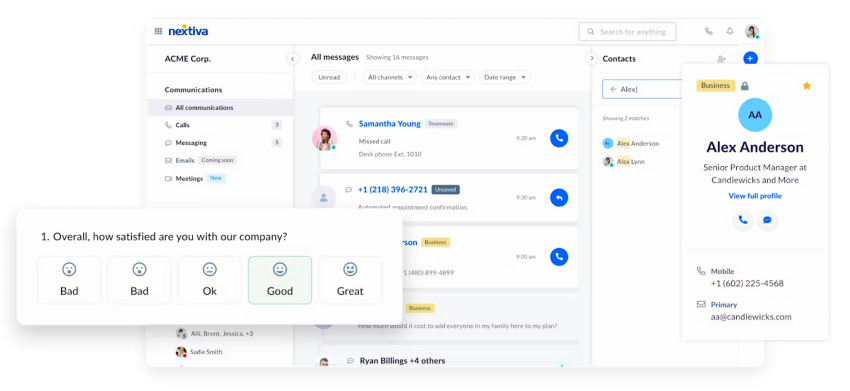
3. Company Cell Phones
Some companies reimburse or subsidize mobile phones and handsets for their staff — a considerable financial burden often exceeding $50/month per user. However, such reimbursements are more of a perk than the norm — it adds up, especially if someone consumes a lot of data.
Alternatively, business VoIP systems, which provide softphone mobile apps that employees can download to their personal mobile devices at no extra cost, are estimated to be just 8% of an IT department’s budget — a significant reduction for a company that previously provided cell phones and desk phones to their employees.
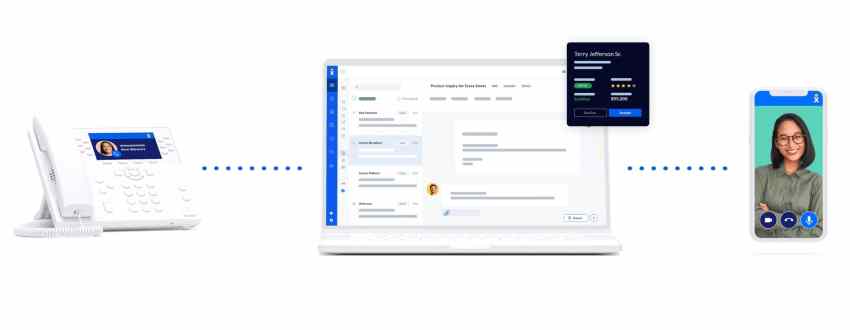
4. Operational Security
Operational security is paramount, especially when immediate action is required to lock down communications — something personal SMS and messaging apps aren’t designed for.
Furthermore, if employees use non-standard communications or personal messaging apps for work purposes, this can create an increased risk for HR and legal teams.
VoIP systems provide a unified communications solution with robust security features that allow for quick action in case of security threats.
Evaluating the security protocols and features of a VoIP system compared to standalone personal communication apps offers insight into the level of control and security afforded by integrating communications onto a single platform.
Business VoIP vs. Traditional Phone Systems
With each system bringing its own set of financial implications, weighing VoIP vs. conventional phone systems extends beyond mere functionality.
Knowing how each system will impact your business is important, as this also contributes to the expenses you must consider before committing to one system or the other.
Staffing:
- Traditional phone systems, such as private branch exchanges (PBX), call for dedicated staff for management and maintenance, which adds to operational costs.
- VoIP systems are far more straightforward and need less technical oversight, which reduces their complexity and staffing costs.
Equipment:
- Traditional on-premise phone systems’ costs are hefty, especially when compared to VoIP hardware.
- VoIP systems have far lower upfront hardware costs, leading to a more cost-effective setup.
Infrastructure:
- Conventional analog phone systems rely on copper wiring, which is notoriously expensive to install and maintain.
- Virtual phone systems, such as VoIP, however, use internet connections.
Switching Providers:
- Migrating from a traditional phone system to VoIP does come with certain costs, which include phone number porting, purchasing new equipment, and staff training. However, the transition leads to short- and long-term savings while also increasing efficiency.
Number of Phone Lines:
- VoIP systems offer better scalability, allowing for easy addition or reduction of phone lines without needing hardware changes. This directly leads to cost savings, as businesses only pay for the lines they need.
High-Speed Internet Costs:
- High-speed internet is a prerequisite for VoIP, but not conventional phone systems. However, most modern businesses already have high-speed internet, meaning this requirement isn’t a burden when installing a VoIP system.
Long-Distance Calling:
- Long-distance calling is also cheaper with VoIP due to its real-time, internet-based nature, eliminating the need for telephony networks that drive up the cost of long-distance voice calls.
Set-up Fees:
- Legacy phone systems have higher set-up fees due to the need for physical hardware and wiring installations.
- VoIP systems have lower setup costs as they leverage existing internet infrastructure.
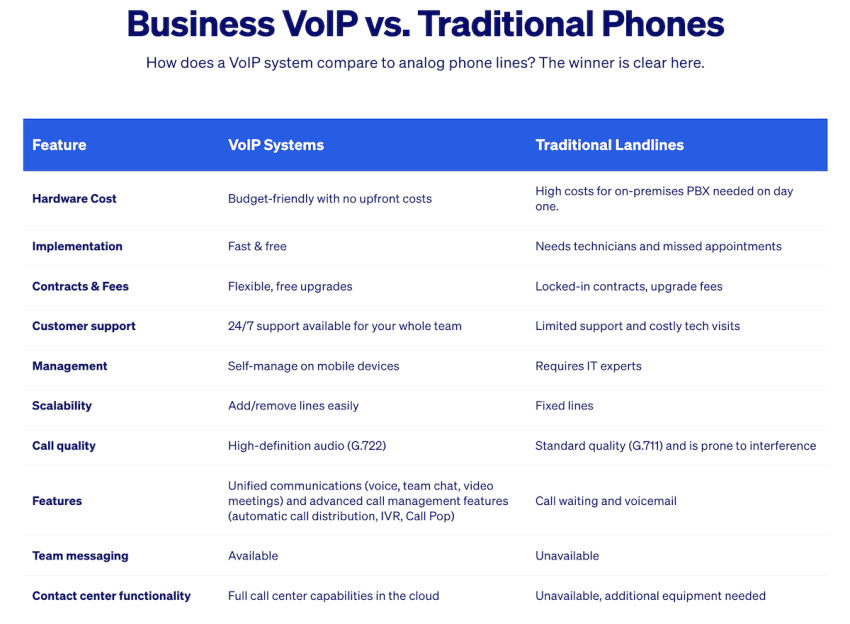
ROI of VoIP: Is It Worth It?
Now that we’ve covered what goes into VoIP phone system costs, we need to decide whether or not investing in a VoIP system is the right decision for your company’s communications.
There are many considerations to take into account, such as lower costs, increased productivity, better customer experience, improved business continuity, and operational flexibility.
✅ Measurable Cost Savings
The direct cost of one phone system over another is often the first thing to consider.
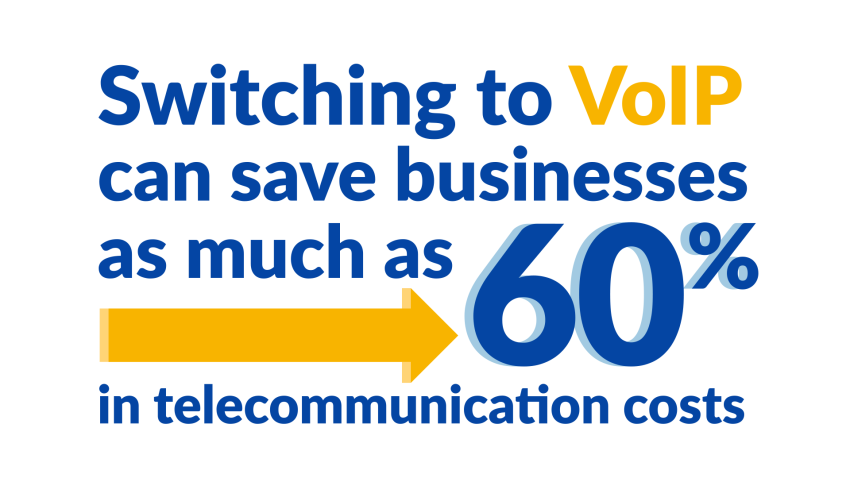
For example, a business with 100 employees looking into a robust communications platform will likely consider a cloud-based phone system, or they might wonder if it’s better to use their budget to go with an on-premises PBX. Let’s dive in.
For 100 users, Nextiva’s Core plan at $15/user/month (billed annually) would cost just under $18,000 in one year.
You’d get every communication feature available today, including unlimited nationwide calling, video meetings, simple IVR, mobile/desktop apps, AI-powered voicemail transcription, and business SMS. Plus, there’s nothing you have to install — simply adjust a few settings online, and you’re done.
On the other hand, if you go down the traditional PBX route, you’ll need to invest upfront in technology and spend a non-trivial amount of time to set it up.
PBX one-time costs (per user):
- Desk phones: $100
- Headsets: $25
- PBX server/hosting: TBD
- Installation: TBD
PBX monthly costs (per user):
- Video conferencing service: $15
- Team messaging: $12.50
- SIP trunking service: $14
PBX total based on 100 employees:
- One-time costs: $12,500
- Recurring costs: $4,150 ($49,800 annually)
All in all, a PBX will set you back over $62,000 in your first year, not including the IT expertise necessary to set it up and maintain it.
It quickly becomes clear that a complete VoIP solution like Nextiva is far more cost-effective than a traditional phone system. In the example above, Nextiva saves you over 60%, excluding taxes/fees.
For international calling, some providers may offer bundled international calling packages with discounted rates for specific regions or countries, or specialize in international calls and offer competitive rates for specific destinations. These providers leverage economies of scale to offer lower costs.
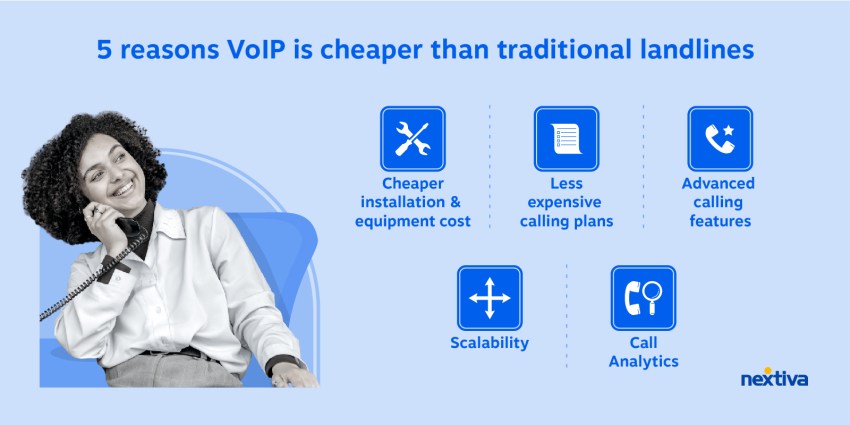
Besides the cost savings, there are other areas to see the upside of VoIP.
✅ Enhanced Team Productivity
Integrating your phone system and other business applications streamlines workflow, which enhances team productivity.
Moreover, VoIP supports remote work with advanced features, making it an indispensable tool in today’s modern, flexible work environment (in which more than 4.7 million people are now working remotely).
✅ Better Customer Experience
High-definition call quality and flexible call routing are hallmark features of VoIP, which result in an improved customer experience.
Seamless integration with your CRM software and other key customer data platforms enriches customer interaction, making every communication more insightful and effective.
Likewise, if customers or partners call an employee and they’re not available or it’s after hours, calls can be forwarded to a preferred destination — even your cell phone.
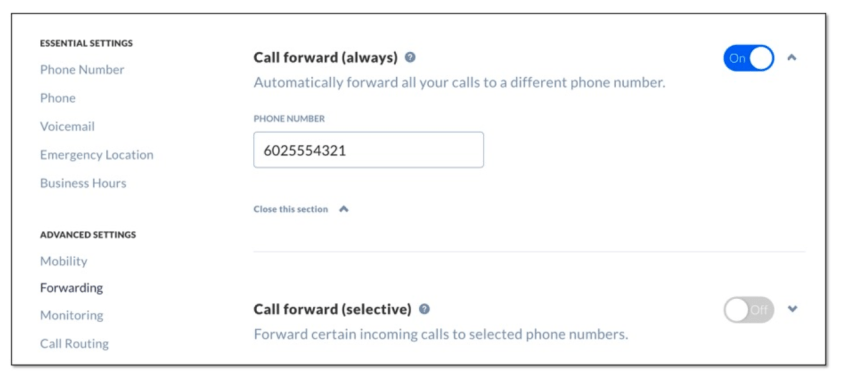
✅ Increased Business Continuity
In the face of unexpected outages, the quick rerouting capabilities of VoIP ensure that business communication remains uninterrupted. High uptime is often part of the service-level agreements with VoIP providers, affirming a reliable communication backbone for businesses.
Nextiva has eight redundant data centers located across North America. This means your team has ultra-high reliability and accessibility, as well as superior VoIP call quality. In addition, the network is actively monitored to ensure nothing stands in the way of you talking with your customers.
✅ More Operational Flexibility
VoIP not only supports remote work but also facilitates global expansion by unifying communication across geographical boundaries.
And if you decide to forego the office building, there’s not a massive undertaking you need to do to maintain reliable communication. Desktop, mobile, and web apps keep everyone connected.
The digital call recording, storage, and easy access to phone call logs provide operational flexibility for modern businesses that need to scale effectively.

Why Choose Nextiva for Small Business VoIP?
Switching to a VoIP phone system is a smart step towards updating your business communications to match today’s digital needs. It’s both an investment and a cost.
VoIP pricing doesn’t have to be complicated. Think about your needs today and where your company is going. How do you envision the best way for your team to communicate? It’s probably not using a patchwork of various tools.
Instead, opt for a unified communications solution like Nextiva and focus on serving your customers. We offer:
- Unmatched features (our small business phone plans include a robust suite of calling features)
- Superior reliability & security (uptime of 99.999% and industry-standard compliance, data protection, and security)
- Instant scalability (adding a new location? working from home? add business phone numbers and toggle advanced features instantly)
- Hassle-free PBX (no updates or costly hardware to deal with)
- Surprisingly affordable (lower phone service costs by over 60% vs. traditional landlines, and we offer transparent pricing)
- Amazing Service® (our knowledgeable and friendly customer support team is available 24/7 over the phone, email, and chat)
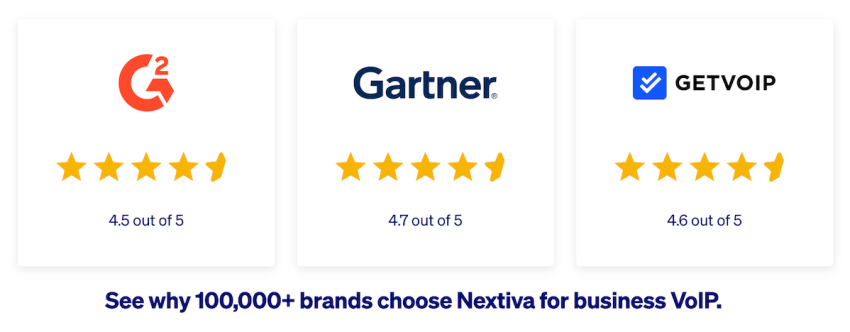
The Bottom Line: Transparent VoIP Pricing
With Nextiva, what you see is what you pay. Our all-inclusive plans eliminate the guesswork around VoIP costs:
- No setup or installation fees
- Number porting included at no cost
- Essential features included, not add-ons
- Predictable per-user pricing as you scale
- Go live in under an hour with no IT dependency
Ready to see exactly what VoIP will cost your business? Our pricing is transparent, our setup is simple, and our support team is standing by to help you get started.
Switch to Nextiva today and save up to 60%
Join now and start calling in less than 10 minutes. Instant set up. Enterprise-grade reliability.

















 VoIP
VoIP 









